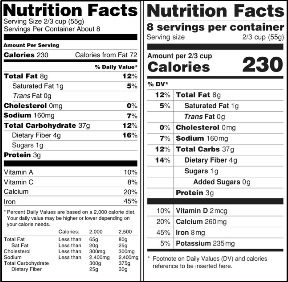Nutrition Facts labels may soon make it easier for you to eat healthier. Twenty years after labels became standard for most prepared foods, such as breads, cereals, canned and frozen foods, snacks, desserts and drinks, the FDA announced plans this year to update the Nutrition Facts labels found on most food packages in the United States. Nutrition labeling for raw produce (fruits and vegetables) and fish is voluntary.
Among the proposed changes are:
- Larger and bolder text for calories. It’s important to look at calories because weight creep is common as we get older, says Jill Weisenberger, MS, RDN, CDE, author of Diabetes Weight Loss – Week by Week. “If calories are more prominent and easier to notice, we might become more focused on calorie-control for weight loss and this is a good thing.”
- The number of servings (or portion size) will be more prominent and better reflect the realistic amount a person eats or drinks. “Amount per serving,” would list the actual serving size, e.g. “Amount per cup.” There is also a proposal to present “dual column” labels to indicate both “per serving” and “per package” calorie and nutrition information for larger packages of food or drinks that could be eaten in one sitting or multiple sittings. “I do see a lot of people confused about serving sizes,” says Weisenberger. “For example, lots of beverages come in 20-ounce bottles and list 2.5 – not one – serving per container. Some muffins list two servings; even though most people probably think that a muffin is a single serving.”

- “Added sugars” will be included. These are the sugars that manufacturers add to food. According to the FDA, on the average, people in the USA eat 16 percent of their daily calories from sugars added during food production to items such as cereals, bread, spaghetti sauce, etc. “As we age, we need to get the most nutrient dense foods,” says Weisenberger. “Identifying added sugars will help. Right now, we can’t tell if the sugar listed on the Nutrition Facts panel comes from nutrient dense fruit or milk or if it comes from nutrient-poor added sugars and syrups.”
- Vitamin D and potassium amounts will be required. Vitamin D is linked to healthy bones (something important for the over 40 woman), and potassium helps to lower blood pressure and prevent hypertension. FDA officials say consumers are lacking in both these nutrients. Labeling will no longer be required for Vitamins A and C.
- Revise the Daily Values. This will include values for a variety of nutrients such as sodium, dietary fiber and Vitamin D. The %DV will also shift to the left of the label to make it easier for consumers to see the nutrient information.
Weisenberger also says that she would like to see actual trans fat (which increases LDL “bad” cholesterol) listed even for foods that contain this fat in smaller amounts. Currently, any food with less than half a gram (0.5) of trans fats per serving is listed as having 0 trans fat.
In conjunction with that, be alert for the sodium content as well since it increases blood pressure. “For adults between the ages of 40 and 70, each increment of 20 mmHg in SBP doubles the risk of cardiovascular disease across the blood pressure range from 115/75 to 185/115,” says Weisenberger. “Each increment of 10 mmHg in diastolic blood pressure doubles the risk of cardiovascular disease across the blood pressure range from 115/75 to 185/115.”
According to a study released earlier this year by the USDA, 42 percent of working age adults (between ages of 29 and 68) and 57 percent of older adults reported using the Nutrition Facts Panel most or all of the time when making food choices.
The public had until June 2, 2014 to comment on the proposed changes. Now that comments are closed, the final decision could take months. Once finalized, the FDA will give food manufacturers two years to implement the changes.

